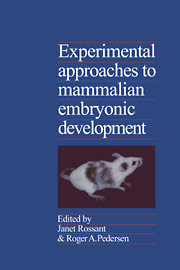Book contents
- Frontmatter
- Contents
- Preface
- Contributors
- Cellular aspects
- Molecular and biochemical aspects
- 6 Regulation of gene expression during mammalian spermatogenesis
- 7 Molecular aspects of mammalian oocyte growth and maturation
- 8 Utilization of genetic information in the preimplantation mouse embryo
- 9 Metabolic aspects of the physiology of the preimplantation embryo
- 10 Role of cell surface molecules in early mammalian development
- 11 Cell-lineage-specific gene expression in development
- 12 X-chromosome regulation in oogenesis and early mammalian development
- Toward a genetic understanding of development
- Index
6 - Regulation of gene expression during mammalian spermatogenesis
from Molecular and biochemical aspects
Published online by Cambridge University Press: 31 March 2010
- Frontmatter
- Contents
- Preface
- Contributors
- Cellular aspects
- Molecular and biochemical aspects
- 6 Regulation of gene expression during mammalian spermatogenesis
- 7 Molecular aspects of mammalian oocyte growth and maturation
- 8 Utilization of genetic information in the preimplantation mouse embryo
- 9 Metabolic aspects of the physiology of the preimplantation embryo
- 10 Role of cell surface molecules in early mammalian development
- 11 Cell-lineage-specific gene expression in development
- 12 X-chromosome regulation in oogenesis and early mammalian development
- Toward a genetic understanding of development
- Index
Summary
Introduction
Spermatogenesis is the process of cellular differentiation in which diploid progenitor cells in the testis differentiate into haploid spermatozoa. During meiosis–one of the central events of spermatogenesis–chromosomes pair, and genetic recombination occurs in the functionally tetraploid pachytene spermatocyte. Numerous cytological studies have described in detail the dramatic morphological changes that the differentiating cells undergo and the unique structures that appear during the development and maturation of the male gamete. These structural data provide an excellent framework on which to investigate at a molecular level the changes in testicular gene expression that underlie the developmental events. Moreover, the testis provides a superior system to study certain eukaryotic control mechanisms. The ordered differentiation of the germ cells allows analysis of the temporal regulation of gene expression for a series of defined proteins in a terminally differentiating system. Furthermore, because transcription terminates early during spermiogenesis, translational regulation of stored mRNA is essential to synthesize many of the proteins appearing during this haploid phase of spermatogenesis. A more complete understanding of the biochemistry of spermatogenesis and the roles played by the plethora of distinct testicular proteins will also disclose many essential regulatory mechanisms unique to the development of the male gamete.
In this chapter, the literature on gene expression during spermatogenesis in mammals will be examined. Although it will be directed toward mammals, pertinent information from nonmammalian species will be included.
- Type
- Chapter
- Information
- Experimental Approaches to Mammalian Embryonic Development , pp. 151 - 194Publisher: Cambridge University PressPrint publication year: 1987
- 3
- Cited by



